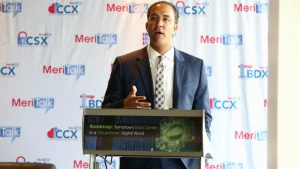In another effort from Congress to expand transparency in U.S. election systems after, Sens. Ben Cardin, D-Md., Amy Klobuchar, D-Minn., and Chris Van Hollen, D-Md. announced today that they will reintroduce their Election Systems Integrity Act.
Sen. Kamala Harris, D-Calif., on Thursday introduced the Digital Service Act, which would increase funding for the U.S. Digital Service (USDS) and provide a conduit for state and local governments to get USDS grants to fund information technology (IT) modernization efforts.
The state of Vermont agreed on Thursday to suspend enforcement of its net neutrality lawsuit until a suit against the Federal Communication Commission (FCC) is resolved. Similarly, telecommunication sector trade groups, who were suing Vermont over the law, agreed to delay their litigation.
Rep. William Hurd, R-Texas, stressed at IBM’s Think Gov event today that America needs to lead the world in developing 5G wireless networks and artificial intelligence (AI) capabilities, especially with China on the rise as a voracious international competitor, and said successful development and application of the two technologies are inextricably linked.
For the second time in as many years, the tornado sirens in Dallas County, Texas have been hacked.
Jackson County, Ga., paid cybercriminals $400,000 to remove ransomware that infected its IT systems. The ransomware, known as Ryuk Ransomware, hit the county on March 1 and impacted multiple county agencies, including the Sheriff’s Office.
The U.S. cloud computing economy tripled in size from 2002 to 2017, and added $214 billion to the U.S. gross domestic product in 2017, according to an Internet Association (IA) report released Tuesday.
Denver is hopping on the app-based voting bandwagon ahead of the 2020 elections.
Columbus State Community College, in Columbus, Ohio, today announced it is going to start a new two-year degree program that will lead students to pursue a career in cloud computing. The program is being developed in partnership with Northern Virginia Community College (NOVA) and Amazon Web Services Educate.
Legislation introduced on Friday by Texas State Senator Jane Nelson seeks to strengthen the state’s push to the cloud, the role of the Chief Data Officer, and the state’s IT modernization efforts.
Recent
-
 Trump Signs Order to Preempt State AI Laws and Push Single Federal Framework
Trump Signs Order to Preempt State AI Laws and Push Single Federal Framework -
 Government, Industry, Academia Collaboration Fuels AI Progress
Government, Industry, Academia Collaboration Fuels AI Progress -
 Indiana DOE Partnership Targets STEM, Digital Learning Tools
Indiana DOE Partnership Targets STEM, Digital Learning Tools -
 States, Schools Harness Data and Workforce Programs to Combat Fraud, Cyber Threats, and Service Outages
States, Schools Harness Data and Workforce Programs to Combat Fraud, Cyber Threats, and Service Outages









